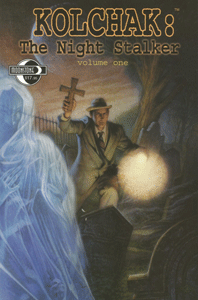“Kolchak: The Night Stalker” scholar Mark Dawidziak correctly points out in the introduction to the Volume One trade paperback that the “Kolchak” saga (at the time of this publication in 2004) runs wide but not deep. We saw the potential in those two films and 22 episodes in the 1970s, but not the full realization of that potential.
One could argue “The X-Files” is the full realization of “Kolchak’s” potential. But as a newspaperman myself, I think the fact that Kolchak is a reporter – without the resources of a government agent – is important. He is even more on his own island than Mulder and Scully are.
Starting in 2002, Moonstone Comics aimed to finally give us the further “Kolchak” adventures we craved, and Volume One collects the first three comic stories, with one bonus yarn. The rest is history, as “Kolchak” comics are still published to this day, along with novels; plus there was the re-imagined TV series in 2005.

“Kolchak: The Night Stalker” Volume One (2004)
Collects: “The Night Stalker” (2002), “Get of Belial” (2002), “Fever Pitch” (2002) and “Mask of Moment” (2004)
Writers: Jeff Rice, Joe Gentile (adapting Donn Mullally), Stuart M. Kaminsky, Stefan Petrucha
Artists: Gordon Purcell, Art Nichols, Ken Wolak, Dawn Groszewski, Jeremy Roberts, Christopher Jones, Barbara Schulz, Andre Maitland, Andy Bennett, Dave Aikins, Wally Lowe, Terry Pallot
Back where it all began
The first of the four stories is “The Night Stalker” (2002), Jeff Rice’s adaptation of the 1972 movie that was itself adapted from his novel. This is the weakest entry, but that’s not a bad thing; it shows how good the other three are.
I hadn’t watched the movie recently enough to automatically find this story rote, so I suspect the story is rather rote. Maybe it wasn’t in 1972. Kolchak (obviously correctly) believes the titular villain is a vampire. His editor Vincenzo and the authorities make fun of him in the newsroom and at press conferences, even as the bodies pile up in Las Vegas.
Interestingly, the comic – if my memory of the film serves — puts more emphasis on the cover-up than on the vampire. Authorities frame Kolchak for the vampire’s killing, and thus they have a card to play to force Kolchak to not run a truthful story.
As for why, we don’t really know. That’s one of the odd things about those Seventies “Kolchak” stories: Authorities cover up everything, even if it’s not their own conspiracy.
Unfortunately, Rice chooses to establish a sliding timeline for these “Kolchak” comics. Sliding timelines are often used in superhero comics, plus cartoons such as “The Simpsons.” Time moves forward but the characters don’t age. References and computer technology put this story in the 1990s or later. I’d rather have Kolchak doing his thing in the 1970s and then have the comic follow him into the Eighties and Nineties eventually.

A lost episode revived
Up next is “Get of Belial” (2002), adapted by Joe Gentile from Donn Mullally’s unfilmed teleplay. It’s one of three such scripts, along with “Eve of Terror” — also eventually made into a comic — and “The Executioners.”
Like a lot of “Kolchak” episodes, this story’s screen success would’ve depended on whether the director had enough of a budget and talent to create a mood – in this case surrounding a tense West Virginia coal miner strike.
A werewolf story without traditional werewolf rules – and with a religious explanation — “Get” features one quite evocative sequence. Vertically along one side of the page, and drawn tiny by Art Nichols to show proportions, Kolchak climbs down a long mine shaft to look at the monster’s corpse.
Expanding the lore
With “Fever Pitch” (2002), things get really good. Stuart M. Kaminsky pens an original tale of spontaneously exploding humans combined with a fear-based virus. He accidentally comments on the pandemic of two decades later, complete with the creation of this terrifying virus in a lab.
Barbara Schulz inks Christopher Jones’ pencils to create shadows – a contrast from the daylight horror of the first story and slickness of the second. But, to an appealingly greater degree than Volume One’s other stories, Kaminsky gets the humor of “Kolchak.” A running thread finds Carl getting wide-ranging and often contradictory advice over how to cure his flu.
But then it’s back into the shadows. Kolchak doesn’t run away from a good story, but he will run away to save his life if he has to. “Fever Pitch” asks: “What if you had to go against your instincts to save yourself?”
In Volume One’s finale, the short “Mask of Moment” (2004), Topps “X-Files” comic scribe Stefan Petrucha (who will be a legend the day tie-in fiction is finally recognized as a legit art form) further digs into what drives Kolchak to expose the truth of the world. I can hear Darren McGavin reading the voiceover narration in my head in this bleak but thoughtful character study.
The attempt to deepen “Kolchak’s” waters begins successfully. I miss the Seventies, but it’s good to have Kolchak back, and in the good hands of skilled artists (everyone nails McGavin’s likeness) and imaginative storytellers.
Click here to visit our “Kolchak: The Night Stalker” Zone.

